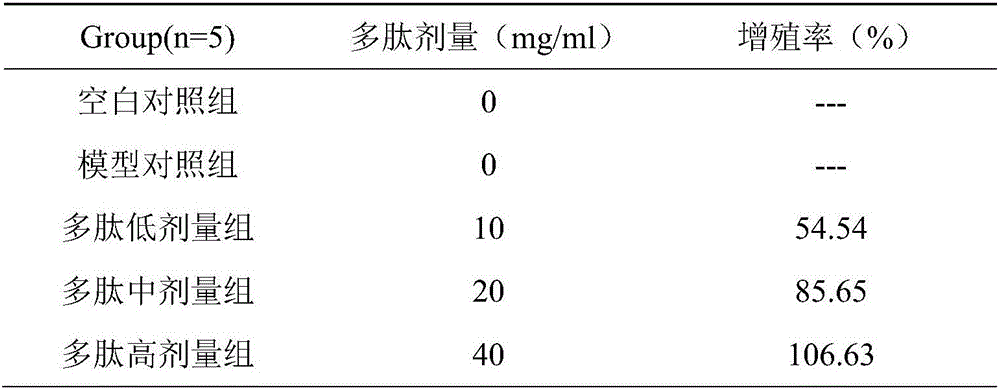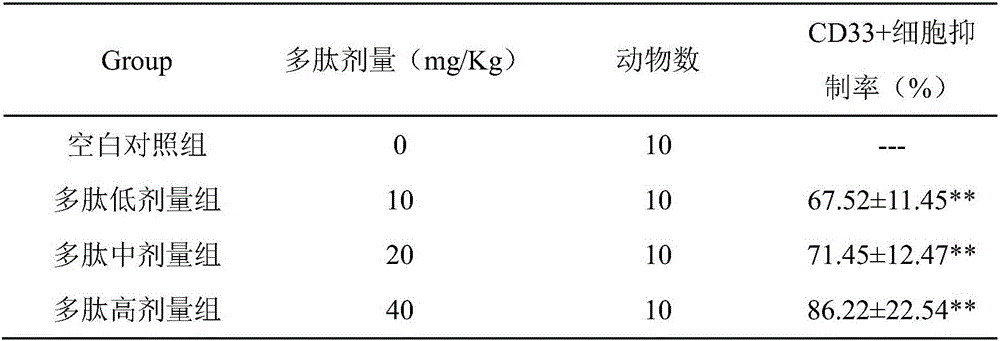CD33 immunogenic polypeptide and application thereof
An immunogen and cellular immunity technology, applied in the direction of specific peptides, cancer antigen components, vertebrate antigen components, etc., can solve the problems of specific T cell immunity, large molecular weight of CD33, difficult CD33, etc., to promote T cell proliferation, Effects of inhibiting growth and inhibiting CD33 expression
- Summary
- Abstract
- Description
- Claims
- Application Information
AI Technical Summary
Problems solved by technology
Method used
Image
Examples
Embodiment 1
[0014] The in vivo activity of CD33 immunogen polypeptide was detected by acute myeloid leukemia mouse model.
[0015] SCID mice aged 6-8w were randomly divided into 4 groups, half male and half male, 10 mice in each group. (1) blank group; (2) low-dose polypeptide group; (3) medium-dose polypeptide group; (4) high-dose polypeptide group. The leukemia animal model was established by intraperitoneal injection of HL-60 cells, and the acute myeloid leukemia mouse model was established. Immunization was carried out on the 3rd, 5th, and 7th day after inoculation of tumor cells. The scheme is: add the same volume of solvent to the blank group, set three doses of polypeptide in the experimental group: 2, 5, and 10 mg / Kg, and inject at multiple points around the tumor. After 21 days, the number of surviving mice was observed, and the survival rate was calculated. The results showed that the peptides at doses of 2, 5, and 10 mg / Kg could effectively protect tumor-bearing mice and impr...
Embodiment 2
[0017] Use the competitive receptor-ligand affinity method to test the binding ability of peptides to MHC:
[0018] The ability of the polypeptide to bind to each type of HLA was judged by the competitive receptor-ligand affinity method. Add 125I-labeled polypeptides with a fixed concentration of 50 μmol / L and polypeptides with different concentrations (1-50 μmol / L) to the reaction system (phosphate buffer and MHC, the MHC kit was purchased from Shanghai Fanke Biotechnology Co., Ltd. , there are HLA-A1, A2, A3, A11 and A24 in the kit), and two complexes are formed in the reaction system, that is, the polypeptide MHC complex to be tested and the 125I-labeled polypeptide complex. The polypeptide to be tested competes with the 125I-labeled polypeptide for binding to MHC. Use ultrafiltration (product model Microcon 30, Amicon company) to separate free polypeptide and polypeptide MHC complex, then measure the 125I radioactivity of the polypeptide MHC complex, and compare this radi...
Embodiment 3
[0020] Proliferation of T lymphocytes: Spleen of mice was aseptically taken, washed 3 times with 1640 medium, ground with a 5ml syringe core, filtered with a 200-mesh screen to make a single-cell suspension, centrifuged (1000r / min, 5min), discarded Qing, Tris-NH 4 CL cracked red blood cells, put them in an ice-water bath for 3-5min, centrifuged (1000r / min, 5min), discarded the supernatant, and washed the cells twice with sterile cold PBS. Add RPMI 1640 culture fluid (5ml) of 10% calf serum to suspend the cells at last, count the cells, and adjust the cell concentration to be 5×10 6 cells / ml and cultured in 96-well culture plates.
[0021] The experiment set up a blank control group, a model group (concanavalin A, purchased from sigma company), and groups of different doses of polypeptides (10, 20, 40 mg / ml). After adding 100 μl / well of spleen lymphocyte suspension to each group, 100 μl of 1640 culture medium was added to the blank control group, ConA (final concentration was...
PUM
 Login to View More
Login to View More Abstract
Description
Claims
Application Information
 Login to View More
Login to View More - R&D Engineer
- R&D Manager
- IP Professional
- Industry Leading Data Capabilities
- Powerful AI technology
- Patent DNA Extraction
Browse by: Latest US Patents, China's latest patents, Technical Efficacy Thesaurus, Application Domain, Technology Topic, Popular Technical Reports.
© 2024 PatSnap. All rights reserved.Legal|Privacy policy|Modern Slavery Act Transparency Statement|Sitemap|About US| Contact US: help@patsnap.com









